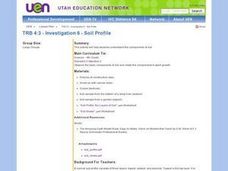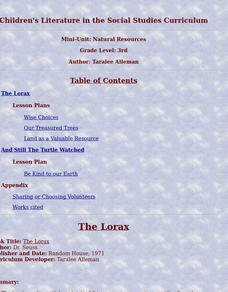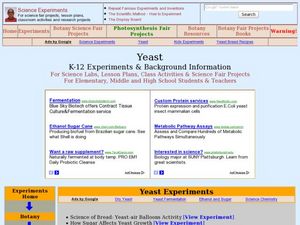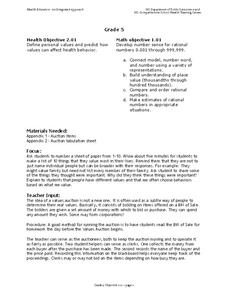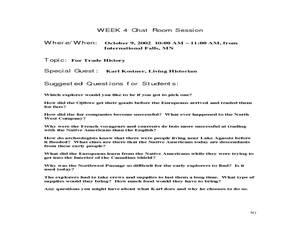Curated OER
Making Community Measurements: Which Plant Part?
Students identify a plant in a given community and make a variety of measurements. They determine how a plant meets its basic needs. In addition to identifying plant parts, they observe seasonal change and compare plants within a community.
Curated OER
Food Webs
Students identify predator/prey relationships based on the food web of the tropical rain forest ecosystem and realize they need a food web for survival. In this food web lesson plan, students complete a role play activity being animals...
Curated OER
Fable of the Fainting Goat
Second graders explore animal life by reading children stories in class. In this goat fable lesson, 2nd graders read several books which describe the different myths and folklore about goats. Students identify the needs of living animals...
Curated OER
Understanding How Potatoes Grow
Second graders make a KWL chart and brainstorm what they need for the project of growing potatoes. They choose one potato and plant it in water or peat moss cups and choose a location in which meets the needs of the plants and make their...
Curated OER
Building Tolerance for Poverty in Math
Students explore approximate and exact solutions. In this interdisciplinary instructional activity, 6th graders will be placed in 'family groups' to create a budget that is subject to random events as chosen from the 'things happen' box....
Curated OER
Water, Water Everywhere (Pond Animals)
Second graders examine the characteristics of animals who live in a pond environment. In groups, they describe the various stages in the life of a frog and identify the characteristics of other pond animals. Using this information,...
Peace Corps
Features of Culture
Young scholars enumerate features of their own culture and evaluate how those features have influenced their lives. They explain that many differences are related to culture-beliefs and ways of living that are handed down from one...
Curated OER
Investigation 6 - Soil Profile
Fourth graders study the components of soil. They observe the basic components of soil and relate the components to plant growth. They record color, texture, and kinds of materials on their profile log (light color, denser, grittier -...
Curated OER
Introducing Biodiversity
Students identify the basic components necessary for biodiversity, the critical and countless benefits of habitats, as well as the serious present and future threats to their ongoing existence.
Curated OER
Once Upon A Bear
Students study different types of bears, their characteristics, and habitats. They discuss what they know and what they want to learn before visiting a website to look at images and information about bears. They listen to teacher read...
Curated OER
Land as a Valuable Resource
Students investigate why the soil is important to our lives. In this natural resources lesson, students have a farmer as a guest speaker. Students begin to understand how farmers use and protect our natural resource. Students write...
Curated OER
The Dinosaur Body
Students recognize that body design affects balance. They investigate the basic structure of a dinosaur body to see how it achieved balance, then build any dinosaur body system they want, using small marshmallows and extra straws as needed.
Curated OER
Sowing Seeds: the Beginning of the Fast Plant Life Cycle
Students plant seeds, observe and tend plants. They identify major plant parts, how to germinate and troubleshoot problems with plants; and, that plants need water, light, and soil nutrients to thrive. They create a Plant Growth Data Log.
Curated OER
Yeast
Students study the characteristics of yeasts. In this biology instructional activity, students conduct experiments to measure yeast respiration. They discuss the favorable conditions needed for growing them.
Curated OER
What Are Cells?
Energize the cells of young biologists with an edible life science activity. Engaging learners in exploring the inner workings of plant and animal cells, this activity involves using colored jello and various sweet and tasty treats to...
Curated OER
Flower Power: Kansas Quarter Reverse
Young scholars examine the Kansas quarter reverse and explore the basic needs and life processes of plants. They take a nature walk around the school and draw living and non-living things. In the classroom the sort the specimens...
Curated OER
Values
Fifth graders participate in a class auction to determine their values. In this health and math lesson plan, 5th graders list the top ten most important things in their lives, then the teacher introduces the idea of a values auction....
Curated OER
Ghost Towns
Fourth graders research and complete a worksheet to understand why towns in Utah became ghost towns. In this ghost town lesson, 4th graders meet with an official to explore what makes a town thrive. Students create original posters...
Curated OER
Crustacean Critters
Young scholars explore the habitats of hermit crabs. In this crustacean lesson, students discover what animals need to survive. Working with live hermit crabs, young scholars explore how hermit crabs have adapted to their habitats.
Curated OER
Songs, Myths and Games
Fourth graders recognize that the Ojibwa lived in a serene environment which shows in their legends. In this songs, myths and games lesson, 4th graders recognize characteristics of the Ojibwas culture through the study of their games,...
Curated OER
"Julie of the Wolves"
Fifth graders research life in Alaska and compare life there to their lives in this instructional activity. They read "Julie of the Wolves." They research through the novel and other reference books facts about the Alaskan climate and...
Curated OER
Pond 2: Life in a Drop of Pond Water
Students observe organisms found in pond water with a microscope. In groups, they discuss how single-celled organisms satisfy their needs for food, water and air. They compare and contrast the needs of macroscopic and microscopic...
Curated OER
Exploring Ecosystems
Fourth graders create an ecosystem as a class. They have already produced smaller ones. They use a pond or something similar on school grounds to meet the needs of certain plants and animals of their ecosystem. Specifically created will...
Curated OER
Thematic Unit on Cats
Students discover in which climates the cats of the world live in. They review the different climates of the world and use maps and globes to help them locate continents.









